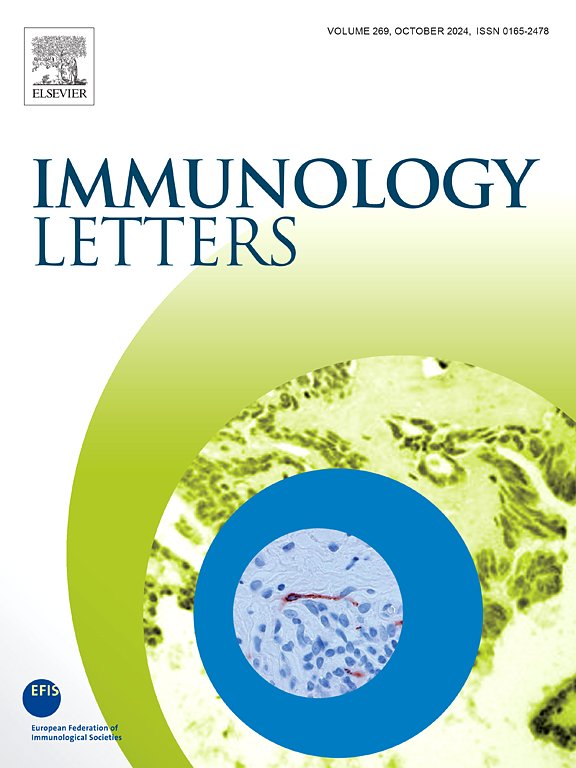Virus-specific antibody responses in severe acute respiratory syndrome coronavirus 2-infected and vaccinated individuals
IF 2.8
4区 医学
Q3 IMMUNOLOGY
引用次数: 0
Abstract
Background
Severe acute respiratory syndrome coronavirus 2 (SARS-CoV-2) infection can have a serious course with many complications, especially in immunocompromised individuals. In such persons, other latent virus infections may contribute to disease pathology, in particular viruses which infect immune cells such as Epstein-Barr virus (EBV) and cytomegalovirus (CMV).
Methods
In this study, serology-based assays were conducted to analyse antibody responses to SARS-CoV-2 spike protein (SP), EBV Epstein-Barr nuclear antigen (EBNA)-1 and CMV phosphoprotein (pp)52 in naturally SARS-CoV-2-infected individuals, non-infected healthy controls (HCs) and vaccinated healthy controls (VHCs) to identify an association between SARS-CoV-2 antibodies and EBV and CMV antibodies in order to determine whether latent EBV and CMV infected individuals are more prone to become infected with SARS-CoV-2. Moreover, SARS-CoV-2, EBV, and CMV antibody responses were characterized in serum from patients with relapsing-remitting multiple sclerosis (RRMS), a chronic inflammatory disease strongly associated with EBV infections, to determine whether the serologic virus antibody profile varies in immunocompromised RRMS individuals upon SARS-CoV-2 vaccinations compared to VHCs.
Results
Significantly elevated SP IgG, IgM and IgA levels were identified in SARS-CoV-2-infected immunocompetent individuals when compared to non-infected HCs. However, no correlation was found to serum antibodies between SARS-CoV-2, EBV, and CMV in individuals infected with SARS-CoV-2 and in VHCs, suggesting that latent infections with neither EBV nor CMV associates to SARS-CoV-2 infection. Moreover, no significant difference in SP IgG, IgA and IgM levels was observed between vaccinated RRMS patients and VHCs, indicating that the immune system of immune deficient RRMS patients and VHCs respond identical to SARS-CoV-2 vaccinations.
Conclusion
Collectively, SARS-CoV-2 SP antibody levels reflect the vaccination and infection history and do not associate with EBV and CMV serostatus.
严重急性呼吸综合征冠状病毒2型感染者和接种者的病毒特异性抗体反应
背景:严重急性呼吸综合征冠状病毒2 (SARS-CoV-2)感染可具有严重的病程和许多并发症,特别是在免疫功能低下的个体中。在这些人中,其他潜伏病毒感染可能导致疾病病理,特别是感染免疫细胞的病毒,如eb病毒(EBV)和巨细胞病毒(CMV)。方法:本研究以血清学为基础,分析了SARS-CoV-2自然感染者对SARS-CoV-2刺突蛋白(SP)、EBNA -1和CMV磷酸蛋白(pp)52的抗体反应。未感染的健康对照(hc)和接种过疫苗的健康对照(vhc)鉴定SARS-CoV-2抗体与EBV和CMV抗体之间的关联,以确定潜伏的EBV和CMV感染者是否更容易感染SARS-CoV-2。此外,研究人员在复发-缓解型多发性硬化症(RRMS)患者(一种与EBV感染密切相关的慢性炎症性疾病)的血清中检测了SARS-CoV-2、EBV和CMV抗体反应,以确定免疫功能低下的RRMS患者接种SARS-CoV-2疫苗后的血清学病毒抗体谱是否与vhc患者不同。结果:与未感染的hc相比,感染sars - cov -2的免疫功能正常个体的SP IgG、IgM和IgA水平显著升高。然而,在SARS-CoV-2感染者和vhc患者中,血清抗体未发现SARS-CoV-2、EBV和CMV之间的相关性,这表明EBV和CMV的潜伏感染与SARS-CoV-2感染无关。此外,免疫缺陷RRMS患者与vhc之间SP IgG、IgA和IgM水平无显著差异,表明免疫缺陷RRMS患者和vhc的免疫系统对SARS-CoV-2疫苗的反应相同。结论:总的来说,SARS-CoV-2 SP抗体水平反映了疫苗接种和感染史,与EBV和CMV血清状态无关。
本文章由计算机程序翻译,如有差异,请以英文原文为准。
求助全文
约1分钟内获得全文
求助全文
来源期刊

Immunology letters
医学-免疫学
CiteScore
7.60
自引率
0.00%
发文量
86
审稿时长
44 days
期刊介绍:
Immunology Letters provides a vehicle for the speedy publication of experimental papers, (mini)Reviews and Letters to the Editor addressing all aspects of molecular and cellular immunology. The essential criteria for publication will be clarity, experimental soundness and novelty. Results contradictory to current accepted thinking or ideas divergent from actual dogmas will be considered for publication provided that they are based on solid experimental findings.
Preference will be given to papers of immediate importance to other investigators, either by their experimental data, new ideas or new methodology. Scientific correspondence to the Editor-in-Chief related to the published papers may also be accepted provided that they are short and scientifically relevant to the papers mentioned, in order to provide a continuing forum for discussion.
 求助内容:
求助内容: 应助结果提醒方式:
应助结果提醒方式:


